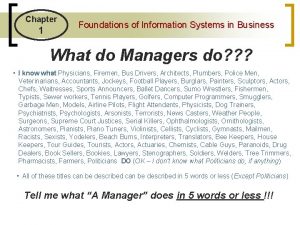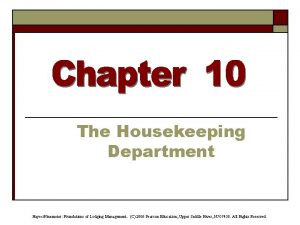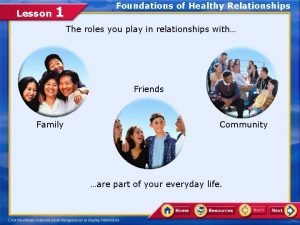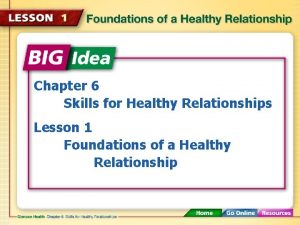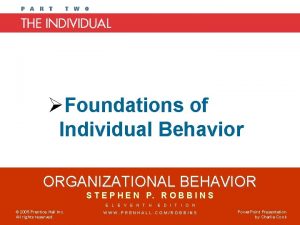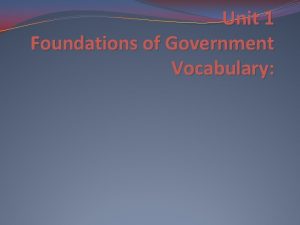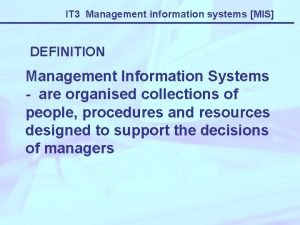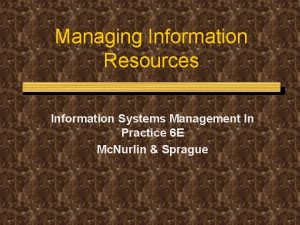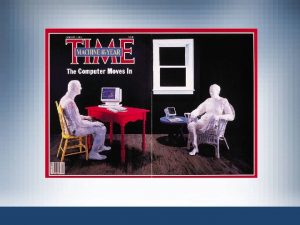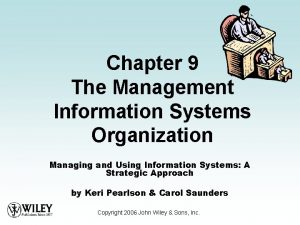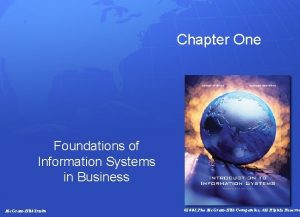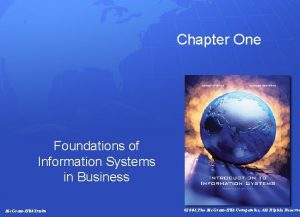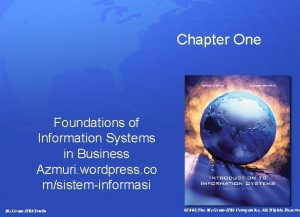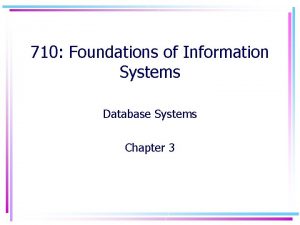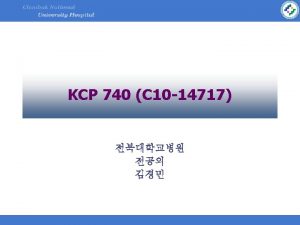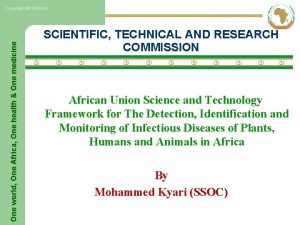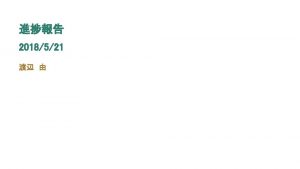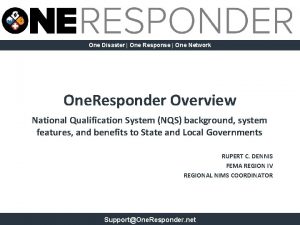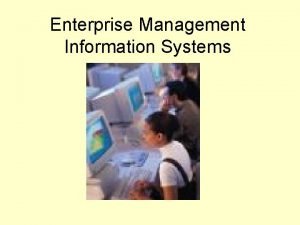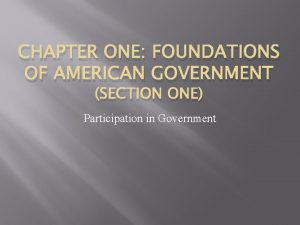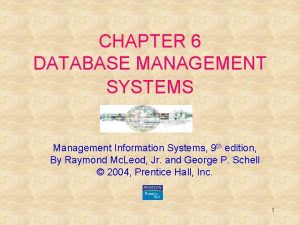Management Information Systems Chapter One Foundations of Information
































- Slides: 32

Management Information Systems Chapter One Foundations of Information Systems in Business Md. Golam Kibria Lecturer, Southeast University

Information System Information system is any organized combination of people, hardware, software, communications networks, and data resources that stores, retrieves, transforms, and disseminates information in an organization.

Information Technology n n Information Technology is the integration of computers, communications equipment, and other technology used in information systems. The technology uses to generate information is called Information Technology ( IT)

Information Systems vs. Information Technology n Information Systems (IS) – all components and resources necessary to deliver information and information processing functions to the organization n Information Technology (IT) – various hardware components necessary for the system to operate

Strategic Business Objectives n Business firms invest heavily in information systems to achieve six strategic business objectives: 1. Operational excellence 2. New products, services, and business models 3. Customer and supplier intimacy 4. Improved decision making 5. Competitive advantage 6. Survival

n Operational excellence: n n n Improvement of efficiency to attain higher profitability Information systems, technology an important tool in achieving greater efficiency and productivity Walmart’s Retail. Link system links suppliers to stores for superior replenishment system

n New products, services, and business models: n n n Business model: describes how company produces, delivers, and sells product or service to create wealth Information systems and technology a major enabling tool for new products, services, business models Examples: Apple’s i. Pod, i. Tunes, i. Phone, i. Pad, Google’s Android OS, and Netflix

n Customer and supplier intimacy: n Serving customers well leads to customers returning, which raises revenues and profits q n Example: High-end hotels that use computers to track customer preferences and use to monitor and customize environment Intimacy with suppliers allows them to provide vital inputs, which lowers costs q Example: J. C. Penney’s information system which links sales records to contract manufacturer

n Improved decision making n Without accurate information: q q n n Managers must use forecasts, best guesses, luck Leads to: § Overproduction, underproduction of goods and services § Misallocation of resources § Poor response times Poor outcomes raise costs, lose customers Example: Verizon’s Web-based digital dashboard to provide managers with real-time data on customer complaints, network performance, line outages, etc.

n Competitive advantage n Delivering better performance n Charging less for superior products n Responding to customers and suppliers in real time n Examples: Apple, Walmart, UPS

n Survival n n Information technologies as necessity of business May be: q Industry-level changes, e. g. Citibank’s introduction of ATMs

Conceptual Framework of IS Knowledge

Conceptual Framework of IS Knowledge n n Foundation Concepts: Fundamental behavioral, technical, business, and managerial concepts about the components and roles of information systems. Information Technologies: Major concepts, development, and management issues in Information technology-that is, hardware, software, networks, data management, internet.

Conceptual Framework of IS Knowledge n n Business Application: The major uses of information systems for the operations, management, competitive advantages of a business. Development Processes: How business professionals and information specialists plan, develop, and implement information systems to meet business opportunities.

Conceptual Framework of IS Knowledge n Management Challenges: The challenges of effectively and ethically managing information technology at the end user, enterprise, global levels of a business.

Roles of IS in Business

Roles of IS in Business n Support business process and operations: As a consumer, you regularly encounter information systems that support the business processes and operations at the many retail stores where you shop. Most retail store now use computer based information systems to help them record customer purchase, keep track of inventory, pay employees, evaluate sales trend.

Roles of IS in Business n n Support Decision Making: Information systems also help store manager and other business professionals make better decision. Support Competitive Advantage: Gaining a strategic advantage over competitors requires innovative applications of information technologies.

Ethical Challenges of IT

Functions of an Information System q q Input Function accepts the input data from outside the system. Processing Function calculates and in other ways manipulates the input and stored data. Output Function produces results of processing for use outside the system. Feedback Function is the output that is returned to appropriate members of the organization to help them evaluate or correct the input state.

Functions of an Information System

Information System Resources n People: People are the essential ingredient for the successful operation of all information systems. These people resources includes– end users and IS specialists. q q End users: End users are people who use an information systems or information it produces. IS specialists: IS specialists are people who develop and operate information systems.

Information System Resources n Hardware – physical devices and materials used in information processing including computer systems, peripherals, and media. n n Computer systems Computer peripherals

Information System Resources n Software: Software includes all sets of information processing instructions. n n n System software, Application software Procedures.

n n Information Systems Resources (con’t) Data Resources – facts or observations about physical phenomena or business transactions Network Resources– communications media and network infrastructure n n Communications Media – examples include twisted-pair wire, coaxial and fiber-optic cables, microwave, cellular, and satellite wireless technologies Network Infrastructure – examples include communications processors such as modems and internetwork processors, and communications control software such as network operating systems and Internet browser packages.

Data vs. Information n Data – raw facts or observations typically about physical phenomena or business transactions. n Information – data that have been converted into a meaningful and useful context for specific end users.

Data Versus Information n n Data is a representation of a fact, a number, a word, an image, a picture or a sound. For example, the number 10 is data; it might represent image, a picture, or a sound. Information is data that is meaningful or useful to someone. For example, the statement “ There are 10 books left in inventory”.

Data versus Information n n a 0 es M 0 1 arl s e 0 o h 0 12 st C M Sh We 54 T 1 79 Monthly Sales Report for West Region Sales Rep: Charles Mann Emp No. 79154 Item Qty Sold Price TM Shoes 1200 $100

Data Vs. Information

n n Information for one person may be data for another. Data for one person may be information for another.

Benefits & Pitfalls of Information Systems Benefits Pitfalls 1. IS can perform calculations or process paperwork much faster than people. 1. By automating activities that were previously performed by people, IS may eliminate job. 2. IS can help companies learn more about the purchase patterns and preferences of their customers. 2. IS may allow organization to collect personal information about people that violate their privacy. 3. IS provide new efficiencies through services such as ATMs, IP telephony, Computer controlled Airplanes and Air Terminals 3. IS are used in so may aspects of everyday life that system outages can cause shutdown of businesses or transportation services, paralyzing communities. 4. IS have made possible new medical advances in surgery, radiology and patient monitoring. 4. Heavy users of IS may suffer repetitive stress injury, technostress and other health problems. 5. The internet distributes information instantly to millions of people across the world. 5. The internet can be used to distribute illegal copies of software, books, articles, and other intellectual property.

Thanks You
 Foundation of information system
Foundation of information system Chapter 1 foundations of government worksheet answers
Chapter 1 foundations of government worksheet answers Functions of an information system
Functions of an information system Introduction to mis
Introduction to mis Opl stands for in housekeeping
Opl stands for in housekeeping Multinational financial management definition
Multinational financial management definition One god one empire one emperor
One god one empire one emperor One one little dog run
One one little dog run One king one law one faith
One king one law one faith One god one empire one emperor
One god one empire one emperor One ford
One ford See one do one teach one
See one do one teach one See one, do one, teach one
See one, do one, teach one Willow cabin speech
Willow cabin speech Studiendekanat uni bonn
Studiendekanat uni bonn Asean tourism strategic plan
Asean tourism strategic plan Graphic organizer with the aims of la liga filipina
Graphic organizer with the aims of la liga filipina Foundations of a healthy relationship
Foundations of a healthy relationship Chapter 6 skills for healthy relationships
Chapter 6 skills for healthy relationships Chapter 2 the nursing assistant and the care team
Chapter 2 the nursing assistant and the care team Foundations of individual behaviour
Foundations of individual behaviour Chapter 4 foundations background to american history
Chapter 4 foundations background to american history Foundations in personal finance chapter 1 review answers
Foundations in personal finance chapter 1 review answers Foundations of government vocabulary
Foundations of government vocabulary Chapter 1: foundations of government pdf
Chapter 1: foundations of government pdf Foundations of government (chapter 1 test form a)
Foundations of government (chapter 1 test form a) Management information systems (mis)
Management information systems (mis) Definition of mis
Definition of mis Information systems management in practice
Information systems management in practice Management information systems 16th edition
Management information systems 16th edition Information
Information Management information systems wiley
Management information systems wiley Management information systems 13th edition
Management information systems 13th edition
